Sustainability Indicators for the Manufacturing and Use of a Fuel Cell Prototype and Hydrogen Storage for Portable Uses
Abstract
:1. Introduction
2. Objective
3. Technical Description of the Fuel Cell
4. Material and Methods
4.1. Life Cycle Assessment
4.2. Multi-Regional Input-Output Assessment
5. Results and Discussion
5.1. Environmental Indicators
5.2. Socio-Economic Indicators
6. Conclusions
Author Contributions
Funding
Institutional Review Board Statement
Informed Consent Statement
Conflicts of Interest
References
- Alaswad, A.; Omran, A.; Sodre, J.R.; Wilberforce, T.; Pignatelli, G.; Dassisti, M.; Baroutaji, A.; Olabi, A.G. Technical and commercial challenges of proton-exchange membrane (PEM) fuel cells. Energies 2020, 14, 144. [Google Scholar] [CrossRef]
- Valente, A.; Iribarren, D.; Dufour, J. End of life of fuel cells and hydrogen products: From technologies to strategies. Int. J. Hydrogen Energy 2019, 44, 20965–20977. [Google Scholar] [CrossRef]
- Pethaiah, S.S.; Sadasivuni, K.K.; Jayakumar, A.; Ponnamma, D.; Tiwary, C.S.; Sasikumar, G. Methanol electrolysis for hydrogen production using polymer electrolyte membrane: A mini-review. Energies 2020, 13, 5879. [Google Scholar] [CrossRef]
- Ferreira-Aparicio, P. Technology indicators of portable power based on hydrogen-fed fuel cells. In Portable Hydrogen Energy Systems; Elsevier: Amsterdam, The Netherlands, 2018; pp. 175–192. [Google Scholar]
- Sapkota, P.; Boyer, C.; Dutta, R.; Cazorla, C.; Aguey-Zinsou, K.-F. Planar polymer electrolyte membrane fuel cells: Powering portable devices from hydrogen. Sustain. Energy Fuels 2020, 4, 439–468. [Google Scholar] [CrossRef]
- Costa, C.; Lizundia, E.; Lanceros-Méndez, S. Polymers for advanced lithium-ion batteries: State of the art and future needs on polymers for the different battery components. Prog. Energy Combust. Sci. 2020, 79, 100846. [Google Scholar] [CrossRef]
- Ziegler, M.S.; Trancik, J.E. Re-examining rates of lithium-ion battery technology improvement and cost decline. Energy Environ. Sci. 2021, 14, 1635–1651. [Google Scholar] [CrossRef]
- Nitta, N.; Wu, F.; Lee, J.T.; Yushin, G. Li-ion battery materials: Present and future. Mater. Today 2015, 18, 252–264. [Google Scholar] [CrossRef]
- Handwerker, M.; Wellnitz, J.; Marzbani, H. Comparison of hydrogen powertrains with the battery powered electric vehicle and investigation of small-scale local hydrogen production using renewable energy. Hydrogen 2021, 2, 5. [Google Scholar] [CrossRef]
- Li, M.; Lu, J. Cobalt in lithium-ion batteries. Science 2020, 367, 979–980. [Google Scholar] [CrossRef]
- Jaskula, B.W. Mineral Commodity Summaries; U.S. Geological Survey: Reston, VA, USA, 2021.
- Harper, G.; Sommerville, R.; Kendrick, E.; Driscoll, L.; Slater, P.; Stolkin, R.; Walton, A.; Christensen, P.; Heidrich, O.; Lambert, S.; et al. Recycling lithium-ion batteries from electric vehicles. Nature 2019, 575, 75–86. [Google Scholar] [CrossRef] [Green Version]
- Li, H.; Alsolami, M.; Yang, S.; Alsmadi, Y.M.; Wang, J. Lifetime test design for second-use electric vehicle batteries in residential applications. IEEE Trans. Sustain. Energy 2017, 8, 1736–1746. [Google Scholar] [CrossRef]
- Second-life Electric Vehicle Batteries 2019–2029. Available online: https://www.idtechex.com/es/research-report/second-life-electric-vehicle-batteries-2019-2029/626 (accessed on 22 September 2021).
- Mubenga, N.S.; Sharma, K.; Stuart, T. A bilevel equalizer to boost the capacity of second life li ion batteries. Batteries 2019, 5, 55. [Google Scholar] [CrossRef] [Green Version]
- Zhang, X.-Q.; Cheng, X.-B.; Zhang, Q. Advances in interfaces between li metal anode and electrolyte. Adv. Mater. Interfaces 2018, 5, 1701097. [Google Scholar] [CrossRef]
- Fan, X.; Chen, L.; Ji, X.; Deng, T.; Hou, S.; Chen, J.; Zheng, J.; Wang, F.; Jiang, J.; Xu, K.; et al. Highly fluorinated interphases enable high-voltage li-metal batteries. Chem 2018, 4, 174–185. [Google Scholar] [CrossRef] [Green Version]
- Li, T.; Liu, H.; Shi, P.; Zhang, Q. Recent progress in carbon/lithium metal composite anode for safe lithium metal batteries. Rare Met. 2018, 37, 449–458. [Google Scholar] [CrossRef]
- Somakettarin, N.; Funaki, T. Study on factors for accurate open circuit voltage characterizations in mn-type li-ion batteries. Batteries 2017, 3, 8. [Google Scholar] [CrossRef]
- Liang, Y.; Zhao, C.; Yuan, H.; Chen, Y.; Zhang, W.; Huang, J.; Yu, D.; Liu, Y.; Titirici, M.; Chueh, Y.; et al. A review of rechargeable batteries for portable electronic devices. InfoMat 2019, 1, 6–32. [Google Scholar] [CrossRef] [Green Version]
- Choi, N.-S.; Chen, Z.; Freunberger, S.A.; Ji, X.; Sun, Y.-K.; Amine, K.; Yushin, G.; Nazar, L.F.; Cho, J.; Bruce, P.G. Challenges facing lithium batteries and electrical double-layer capacitors. Angew. Chem. Int. Ed. 2012, 51, 9994–10024. [Google Scholar] [CrossRef] [PubMed]
- Patil, A.; Patil, V.; Shin, D.W.; Choi, J.-W.; Paik, D.-S.; Yoon, S.-J. Issue and challenges facing rechargeable thin film lithium batteries. Mater. Res. Bull. 2008, 43, 1913–1942. [Google Scholar] [CrossRef]
- Gröger, O.; Gasteiger, H.; Suchsland, J.-P. Review—Electromobility: Batteries or fuel cells? J. Electrochem. Soc. 2015, 162, A2605–A2622. [Google Scholar] [CrossRef]
- Chaparro, A.M.; Ferreira-Aparicio, P.; Folgado-Martínez, M.A.; Conde, J.J.; de Rafael Valdivia, D.; Miguel Verdugo, F.J. Hydrogen-Powered Fuel Cell. Spanish Patent WO2020240063A1, 2020. [Google Scholar]
- Wittstock, R.; Pehlken, A.; Wark, M. Challenges in Automotive Fuel Cells Recycling. Recycling 2016, 1, 343. [Google Scholar] [CrossRef] [Green Version]
- Blake, B.E.; Fenton, S.E. Early life exposure to per- and polyfluoroalkyl substances (PFAS) and latent health outcomes: A review including the placenta as a target tissue and possible driver of peri- and postnatal effects. Toxicology 2020, 443, 152565. [Google Scholar] [CrossRef] [PubMed]
- Stoiber, T.; Evans, S.; Naidenko, O.V. Disposal of products and materials containing per- and polyfluoroalkyl substances (PFAS): A cyclical problem. Chemosphere 2020, 260, 127659. [Google Scholar] [CrossRef] [PubMed]
- EU Project. Fuel Cells and Hydrogen 2 Joint Undertaking Under Grant Agreement No 101007216. Sustainable Solutions for Recycling of End-Of-Life Hydrogen Technologies(Best4Hy Project). Available online: https://best4hy-project.eu/ (accessed on 11 October 2021).
- Pehnt, M. Life-cycle analysis of fuel cell system components. Handb. Fuel Cells 2010, 94, 1293–1317. [Google Scholar] [CrossRef]
- Valente, A.; Iribarren, D.; Dufour, J. Harmonising methodological choices in life cycle assessment of hydrogen: A focus on acidification and renewable hydrogen. Int. J. Hydrogen Energy 2019, 44, 19426–19433. [Google Scholar] [CrossRef]
- Valente, A.; Iribarren, D.; Dufour, J. Cumulative energy demand of hydrogen energy systems. In Environmental Footprints and Eco-Design of Products and Processes; Gabler: Berlin/Heidelberg, Germany, 2018; pp. 47–75. [Google Scholar]
- Valente, A.; Iribarren, D.; Dufour, J. Life cycle sustainability assessment of hydrogen from biomass gasification: A comparison with conventional hydrogen. Int. J. Hydrogen Energy 2019, 44, 21193–21203. [Google Scholar] [CrossRef]
- Valente, A.; Iribarren, D.; Dufour, J. Validation of GreenH2armony® as a tool for the computation of harmonised life-cycle indicators of hydrogen. Energies 2020, 13, 1603. [Google Scholar] [CrossRef] [Green Version]
- Valente, A.; Iribarren, D.; Dufour, J. Harmonised carbon and energy footprints of fossil hydrogen. Int. J. Hydrogen Energy 2021, 46, 17587–17594. [Google Scholar] [CrossRef]
- Valente, A.; Iribarren, D.; Dufour, J. Harmonised life-cycle global warming impact of renewable hydrogen. J. Clean. Prod. 2017, 149, 762–772. [Google Scholar] [CrossRef]
- Valente, A.; Iribarren, D.; Dufour, J. Harmonised life-cycle indicators of nuclear-based hydrogen. Int. J. Hydrogen Energy 2020, 46, 29724–29731. [Google Scholar] [CrossRef]
- Candelaresi, D.; Valente, A.; Iribarren, D.; Dufour, J.; Spazzafumo, G. Comparative life cycle assessment of hydrogen-fuelled passenger cars. Int. J. Hydrogen Energy 2021. [Google Scholar] [CrossRef]
- Bargiacchi, E.; Candelaresi, D.; Valente, A.; Spazzafumo, G.; Frigo, S. Life cycle assessment of substitute natural gas production from biomass and electrolytic hydrogen. Int. J. Hydrogen Energy 2021. [Google Scholar] [CrossRef]
- Wulf, C.; Kaltschmitt, M. Life cycle assessment of hydrogen supply chain with special attention on hydrogen refuelling stations. Int. J. Hydrogen Energy 2012, 37, 16711–16721. [Google Scholar] [CrossRef]
- Ally, J.; Pryor, T. Life-cycle assessment of diesel, natural gas and hydrogen fuel cell bus transportation systems. J. Power Sources 2007, 170, 401–411. [Google Scholar] [CrossRef] [Green Version]
- Bicer, Y.; Dincer, I. Life cycle evaluation of hydrogen and other potential fuels for aircrafts. Int. J. Hydrogen Energy 2017, 42, 10722–10738. [Google Scholar] [CrossRef]
- Mori, M.; Stropnik, R.; Sekavčnik, M.; Lotrič, A. Criticality and life-cycle assessment of materials used in fuel-cell and hydrogen technologies. Sustainability 2021, 13, 3565. [Google Scholar] [CrossRef]
- Garraín, D.; Lechón, Y. Exploratory environmental impact assessment of the manufacturing and disposal stages of a new PEM fuel cell. Int. J. Hydrogen Energy 2014, 39, 1769–1774. [Google Scholar] [CrossRef]
- Usai, L.; Hung, C.R.; Vásquez, F.; Windsheimer, M.; Burheim, O.S.; Strømman, A.H. Life cycle assessment of fuel cell systems for light duty vehicles, current state-of-the-art and future impacts. J. Clean. Prod. 2021, 280, 125086. [Google Scholar] [CrossRef]
- Cox, B.; Bauer, C.; Beltran, A.M.; van Vuuren, D.P.; Mutel, C.L. Life cycle environmental and cost comparison of current and future passenger cars under different energy scenarios. Appl. Energy 2020, 269, 115021. [Google Scholar] [CrossRef]
- Chen, Y.; Hu, X.; Liu, J. Life cycle assessment of fuel cell vehicles considering the detailed vehicle components: Comparison and scenario analysis in China based on different hydrogen production schemes. Energies 2019, 12, 3031. [Google Scholar] [CrossRef] [Green Version]
- Sharma, S.; Ghoshal, S.K. Hydrogen the future transportation fuel: From production to applications. Renew. Sustain. Energy Rev. 2015, 43, 1151–1158. [Google Scholar] [CrossRef]
- Cantuarias-Villessuzanne, C.; Weinberger, B.; Roses, L.; Vignes, A.; Brignon, J.-M. Social cost-benefit analysis of hydrogen mobility in Europe. Int. J. Hydrogen Energy 2016, 41, 19304–19311. [Google Scholar] [CrossRef] [Green Version]
- Sharma, A.; Strezov, V. Life cycle environmental and economic impact assessment of alternative transport fuels and power-train technologies. Energy 2017, 133, 1132–1141. [Google Scholar] [CrossRef]
- Mehmeti, A.; McPhail, S.J.; Pumiglia, D.; Carlini, M. Life cycle sustainability of solid oxide fuel cells: From methodological aspects to system implications. J. Power Sources 2016, 325, 772–785. [Google Scholar] [CrossRef]
- Cai, J.; Gervasio, D.F. The nature of surface oxides on corrosion-resistant nickel alloy covered by alkaline water. Nanoscale Res. Lett. 2010, 5, 613–619. [Google Scholar] [CrossRef] [PubMed] [Green Version]
- Ben Jadi, S.; El Jaouhari, A.; Aouzal, Z.; El Guerraf, A.; Bouabdallaoui, M.; Wang, R.; Bazzaoui, E.; Bazzaoui, M. Electropolymerization and corrosion resistance of polypyrrole on nickel bipolar plate for PEM fuel cell application. Mater. Today Proc. 2020, 22, 52–56. [Google Scholar] [CrossRef]
- ISO, International Standard Organization. Environmental Management—Life Cycle Assessment—Principles and Framework; ISO 14040:2006; ISO: Geneva, Switzerland, 2006. [Google Scholar]
- ISO, International Standard Organization. Environmental Management—Life Cycle Assessment—Requirements and Guidelines; ISO 14044:2006; ISO: Geneva, Switzerland, 2006. [Google Scholar]
- European Union. European commission recommendation 2013/179/EU on the use of common methods to measure and communicate the life cycle environmental performance of products and organisations. Off. J. Eur. Union 2013, 210. [Google Scholar]
- Wolf, M.-A.; Pant, R.; Chomkhamsri, K.; Sala, S.; Pennington, D. The International Reference Life Cycle Data System (ILCD) Handbook; European Commission, Ed.; EC—Joint Research Center—IES: Ispra, Italy, 2012; ISBN 978-927-921-640-4. [Google Scholar]
- Leontief, W.W. Quantitative input and output relations in the economic systems of the United States. Rev. Econ. Stat. 1936, 18, 105. [Google Scholar] [CrossRef] [Green Version]
- Miller, R.E.; Blair, P.D. Input-Output Analysis: Foundations and Extensions; Cambridge University Press: Cambridge, UK, 2009. [Google Scholar]
- Yamano, N.; Ahmad, N. The OECD Input-Output Database: 2006 Edition; STI Working Paper; OECD: Paris, France, 2006. [Google Scholar]
- OECD. OECD Inter-Country Input-Output (ICIO) Tables; OECD: Paris, France; Available online: https://www.oecd.org/sti/ind/inter-country-input-output-tables.htm (accessed on 11 October 2021).
- Wiebe, K.; Yamano, N. Estimating CO2 Emissions Embodied in Final Demand and Trade Using the OECD ICIO 2015: Methodology and Results; OECD Science, Technology and Industry: Paris, France, 2016. [Google Scholar]
- Caldés, N.; Varela, M.; Santamaría, M.; Sáez, R. Economic impact of solar thermal electricity deployment in Spain. Energy Policy 2009, 37, 1628–1636. [Google Scholar] [CrossRef]
- Banacloche, S.; Cadarso, M.A.; Monsalve, F.; Lechon, Y. Assessment of the sustainability of Mexico green investments in the road to Paris. Energy Policy 2020, 141, 111458. [Google Scholar] [CrossRef]
- Banacloche, S.; Cadarso, M.Á.; Monsalve, F. Implications of measuring value added in exports with a regional input-output table. A case of study in South America. Struct. Chang. Econ. Dyn. 2020, 52, 130–140. [Google Scholar] [CrossRef]
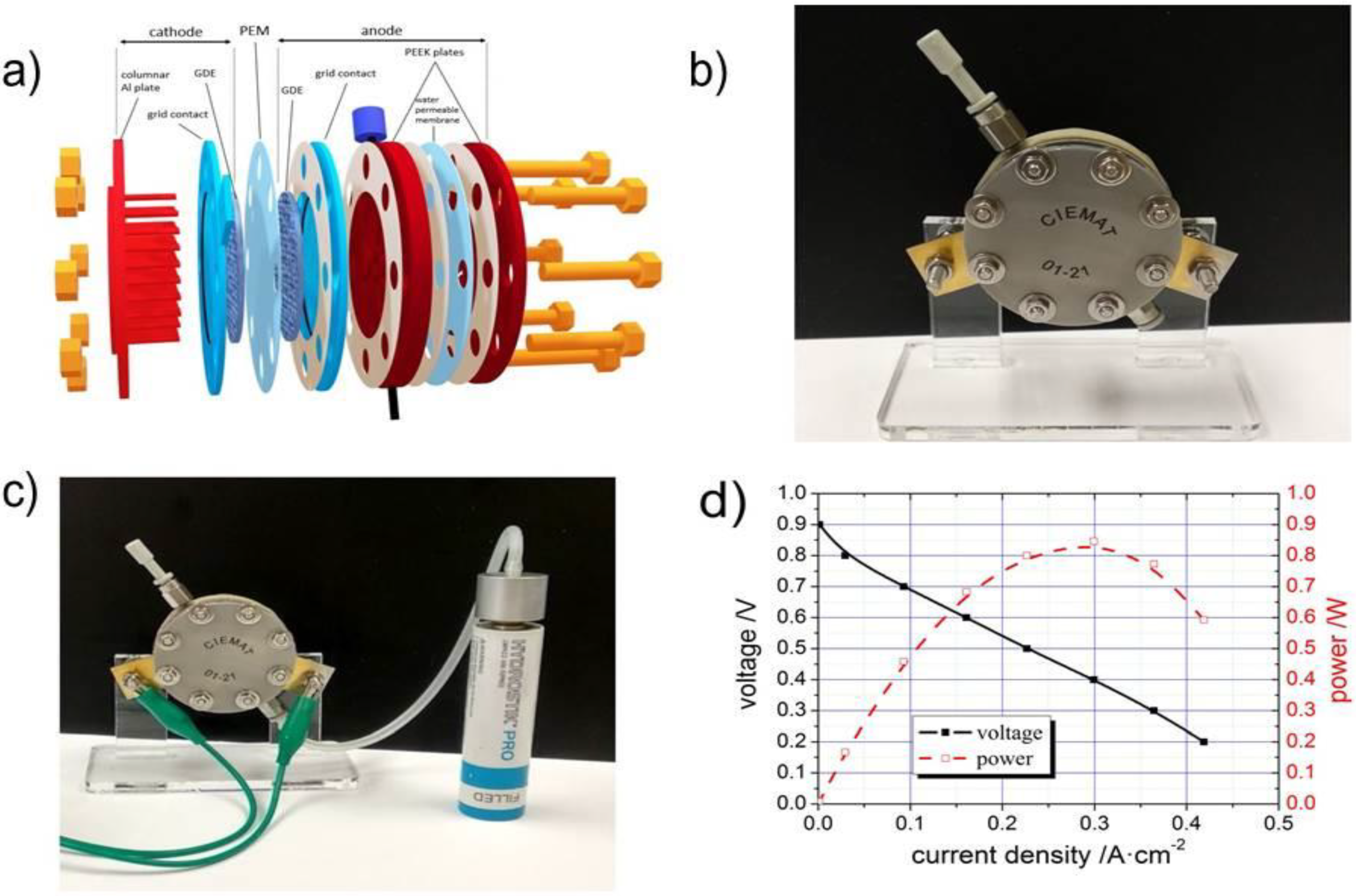

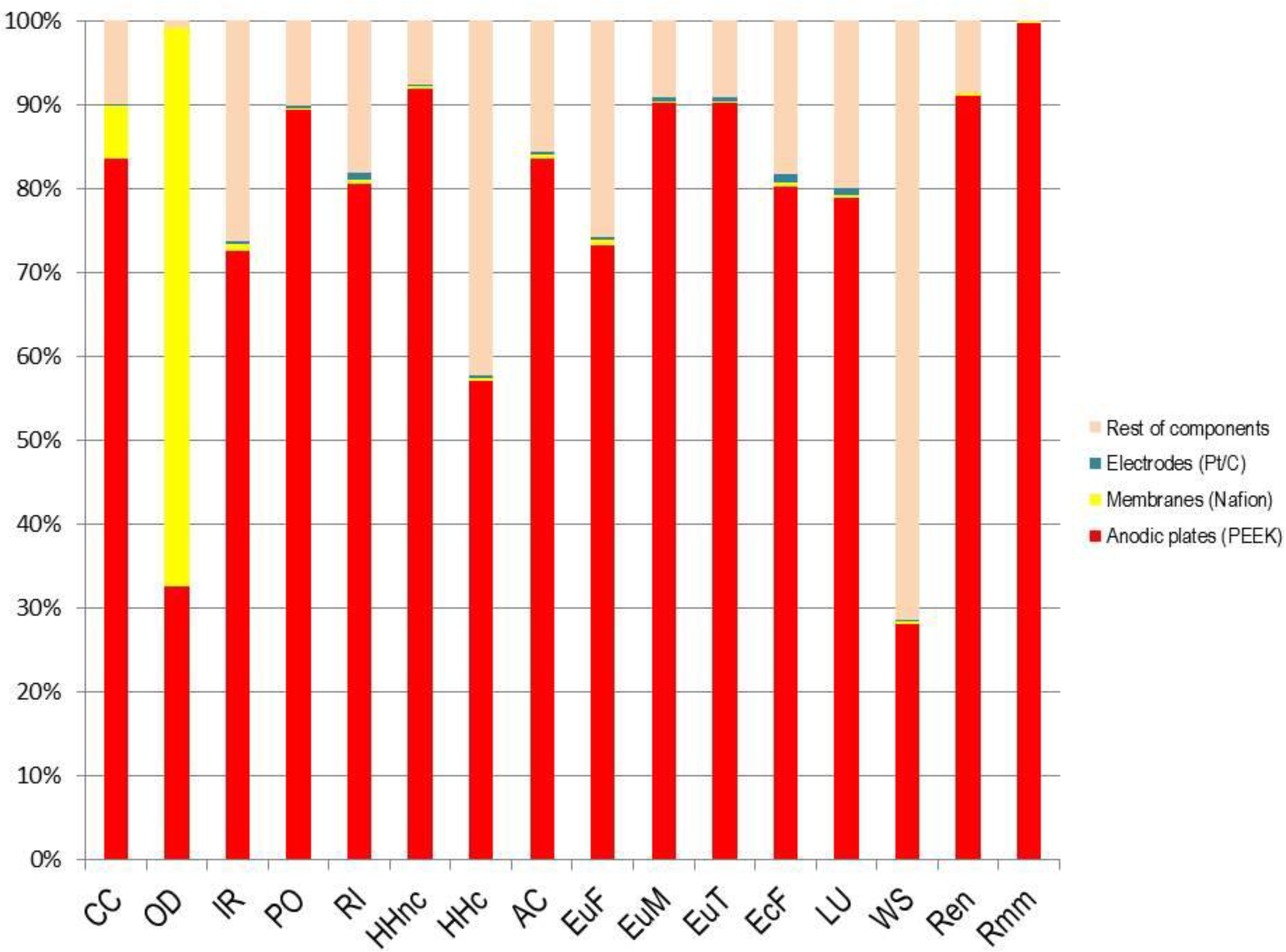
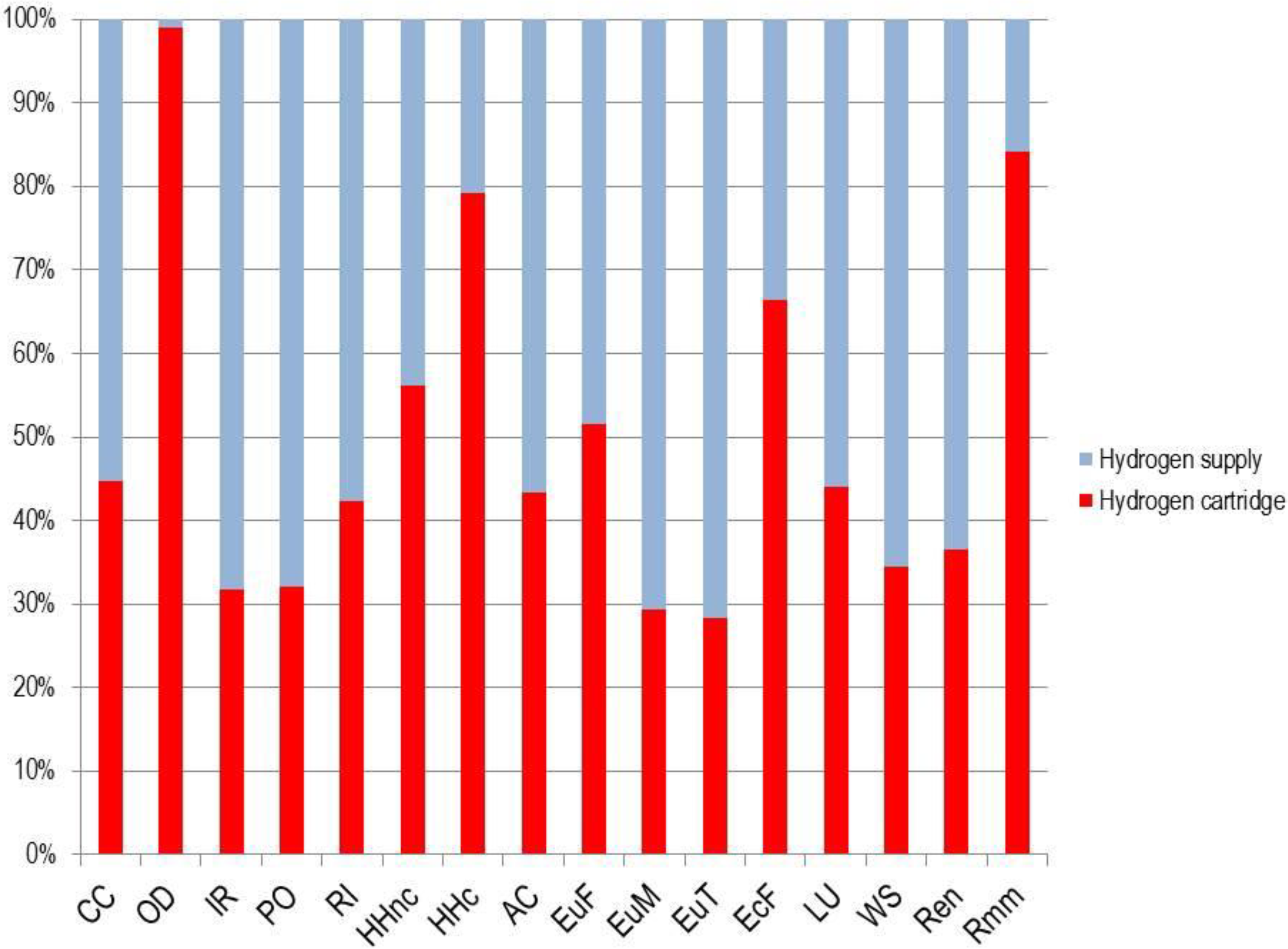
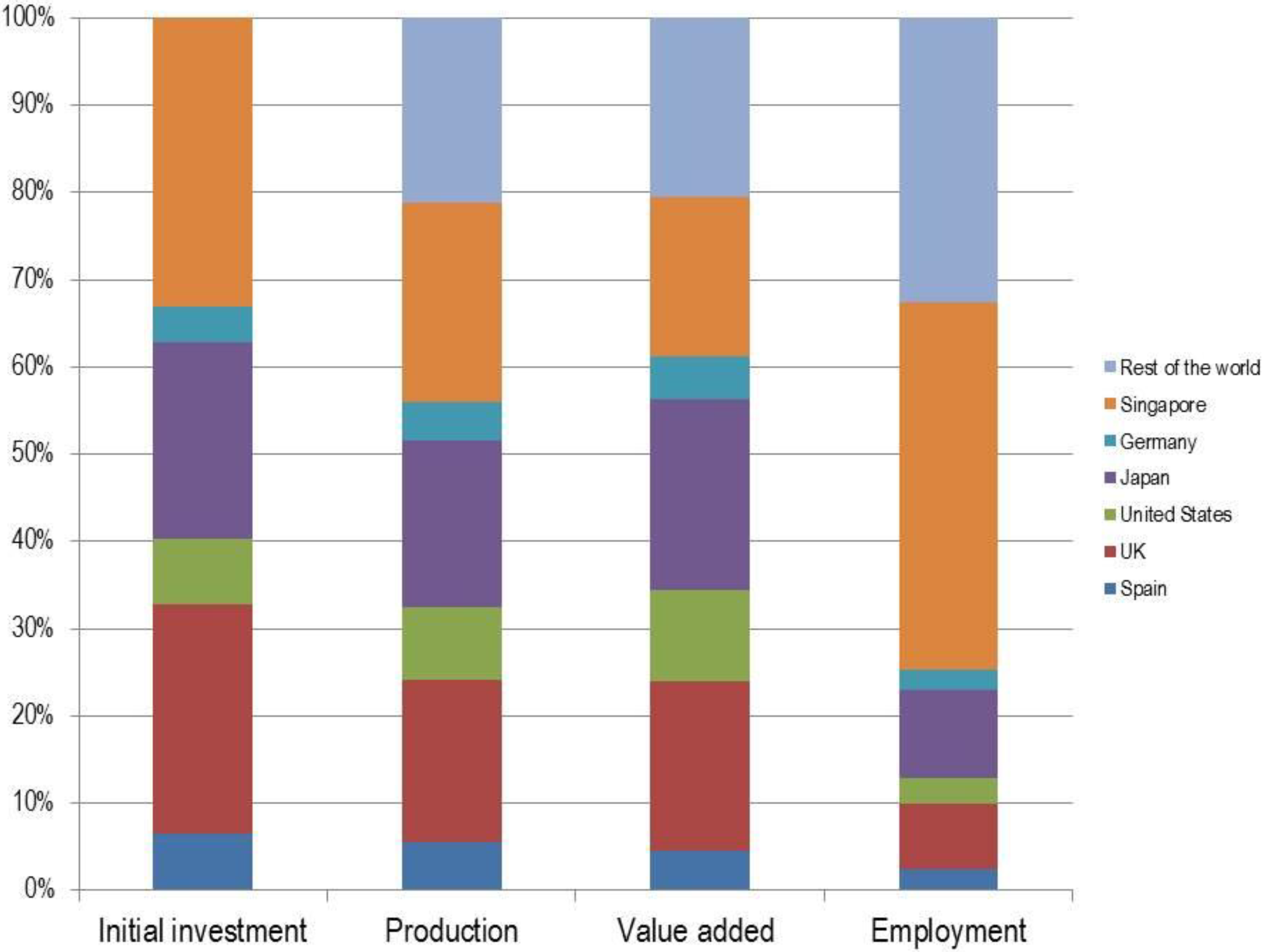
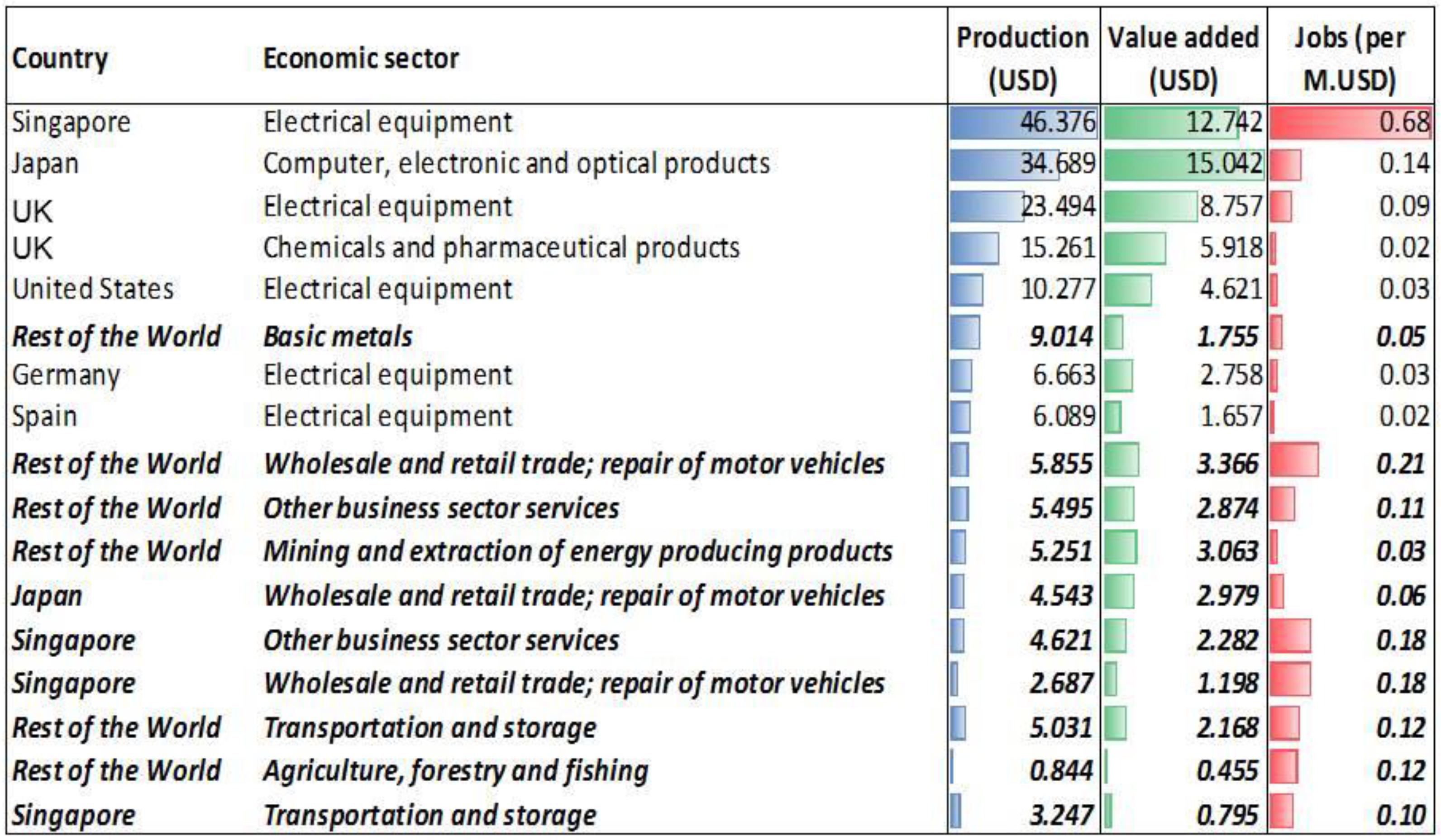
| Part | Component | Material | Weight (g) |
|---|---|---|---|
| Anode | Anodic plate 1 | PEEK | 6.567 |
| Anodic plate 2 | PEEK | 9.175 | |
| Membrane 1 | Nafion (Nf117) | 0.305 | |
| Junction 1 | Silicone | 0.079 | |
| Lock 1 | Stainless steel (screws and washers) | 2.183 | |
| Junction 2 | Silicone | 0.283 | |
| Junction 3 | Silicone | 0.497 | |
| Frame 1 | PET-G (20% carbon fiber) | 1.162 | |
| Grille 1 | Nickel | 0.397 | |
| Electrode 1 | Charcoal cloth + Pt (Pt/C) | 0.151 | |
| Membrane | Membrane 2 | Nafion (Nf112) | 0.293 |
| Cathode | Junction 4 | PET film (Mylar®) | 0.069 |
| Electrode 2 | Charcoal cloth + Pt (Pt/C) | 0.156 | |
| Frame 2 | PET-G (20% carbon fiber) | 1.161 | |
| Frame 3 | Aluminium | 2.278 | |
| Grille 2 | Nickel | 0.399 | |
| Cathodic plate | Aluminum | 17.086 | |
| Cell locks | Lock 2 | Steel | 8.060 |
| Lock 2 | Steel | 2.513 | |
| Gas connectors | Two gas connectors | Reinforced glass fiber | 5.424 |
| Material | Input | Database |
|---|---|---|
| PEEK | Hydroquinone, RER, prod, Alloc Def | Ecoinvent |
| Potassium carbonate, at plant GLO | Ecoinvent | |
| Toluene, at plant, RER | Industry data 2.0 | |
| Electricity, med volt, prod ES, at grid | Ecoinvent | |
| Natural gas, burned, ES | Ecoinvent | |
| Benzyl chloride, at plan, RER | Ecoinvent | |
| Chlorine gas, production mix, RER | Agri-footprint | |
| Aluminium, primary, ingot, GLO, Alloc En | Ecoinvent | |
| Hydrochloric acid, 36% in H2O, from reacting propylene and chlorine, at plant, RER | Ecoinvent | |
| Aniline, at plant, RER | Ecoinvent | |
| Lead, primary, at plant, GLO | Ecoinvent | |
| Sodium hydroxide, 50% in H2O, production mix, at plant, RER | Ecoinvent | |
| Nitric acid, ETH | ETH-ESU | |
| Ammonia, liquid, at reg storehouse, CH | Ecoinvent | |
| Boric acid, anhydrous, at plant, RER | Ecoinvent | |
| Hydrogen fluoride, at plant, GLO | Ecoinvent | |
| Nafion | Tetrafluoroethylene, at plant, RER | Ecoinvent |
| Silicone | Silicone product, at plant, RER | Ecoinvent |
| Stainless steel | X12Cr13 (416) I | IDEMAT |
| Hot rolling, steel, RER | Ecoinvent | |
| PET-G | Polyethylene terephthalate (PET) granulate, production mix, at plant, amorphous, RER | ELCD |
| Carbon fiber I | IDEMAT | |
| Nickel | Nickel, 99.5%, at plant, GLO | Ecoinvent |
| Charcoal cloth | Phosphoric acid, industrial grade, 85% in H2O, at plant, RER | Ecoinvent |
| Textile, woven cotton, at plant, GLO | Ecoinvent | |
| Steel | Reinforcing steel, at plant, RER | Ecoinvent |
| Rolling steel I | IDEMAT | |
| Glass fiber | Glass fibre reinforced plastic, polyester resin, hand lay-up, at plant, RER | Ecoinvent |
| Extrusion, plastic pipes, RER | Ecoinvent |
| Component | Investment Cost Breakdown | Country | €2018 |
|---|---|---|---|
| Cell | 34.15 | ||
| PEEK | UK | 11.76 | |
| Nickel grid | United States | 0.70 | |
| Steel | Spain | 0.10 | |
| Silicone | Spain | 0.10 | |
| Gas diffusion electrode (Pt/C) | United States | 4.00 | |
| Membrane | United States | 4.55 | |
| Screws | Spain | 0.08 | |
| Washers | Spain | 0.08 | |
| Nuts | Spain | 0.08 | |
| M2 screws | Spain | 0.08 | |
| M2 washers | Spain | 0.08 | |
| Stainless steel (Helicoil®) | Spain | 2.32 | |
| Gas connectors (2) | Japan | 5.20 | |
| Aluminium dissipater | Germany | 5.01 | |
| Hydrogen Metals-Hydride Container (H2 reservoir) | Singapore | 40.00 | |
| Portable System | 47.00 | ||
| Pressure control | Japan | 22.00 | |
| Conduits and connectors | Spain | 5.00 | |
| DC-DC conversion | UK | 22.00 | |
| TOTAL | 121.15 | ||
| Country | Sector | Investment Costs ($2015) |
|---|---|---|
| Singapore | Electrical equipment | 46.01 |
| Japan | Computer, electronic and optical products | 31.29 |
| UK | Electrical equipment | 23.01 |
| UK | Chemicals and pharmaceutical products | 13.53 |
| United States | Electrical equipment | 9.84 |
| Germany | Electrical equipment | 5.76 |
| Spain | Electrical equipment | 5.75 |
| Spain | Basic metals | 2.78 |
| United States | Basic metals | 0.81 |
| Spain | Fabricated metal products | 0.46 |
| Spain | Chemicals and pharmaceutical products | 0.12 |
| Impact Category | Unit * | Total Value | % Fuel Cell | % Cartridges |
|---|---|---|---|---|
| Climate change (CC) | kg CO2 eq | 42,500 | 0.19 | 99.81 |
| Ozone depletion (OD) | kg CFC-11 eq | 0.15 | 0.11 | 99.89 |
| Human toxicity, non-cancer effects (HHnc) | CTUh | 3.7 × 10−3 | 0.47 | 99.53 |
| Human toxicity, cancer effects (HHc) | CTUh | 7.8 × 10−4 | 0.16 | 99.84 |
| Respiratory inorganics, particulate matter (RI) | Disease incidence | 1.4 × 10−3 | 0.21 | 99.79 |
| Ionizing radiation (IR) | kBq U235 eq | 18,800 | 0.04 | 99.96 |
| Photochemical ozone formation (PO) | kg NMVOC eq | 135.5 | 0.17 | 99.83 |
| Acidification (AC) | molc H+ eq | 443 | 0.11 | 99.89 |
| Terrestrial eutrophication (EuT) | molc N eq | 461 | 0.17 | 99.83 |
| Freshwater eutrophication (EuF) | kg P eq | 20 | 0.08 | 99.92 |
| Marine eutrophication (EuM) | kg N eq | 45 | 0.15 | 99.85 |
| Freshwater ecotoxicity (EcF) | CTUe | 16,500 | 0.27 | 99.73 |
| Land use (LU) | Pt | 33,400 | 0.12 | 99.88 |
| Water scarcity (WS) | m3 water world eq | 1.19 × 107 1.2 × 107 | 0.08 | 99.92 |
| Resource use (mineral and metals) (Rmm) | kg Sb eq | 0.05 | 4.82 | 95.18 |
| Resource use (energy and fossils) (Ren) | MJ | 6.26 × 105 6.3 × 105 | 0.19 | 99.81 |
Publisher’s Note: MDPI stays neutral with regard to jurisdictional claims in published maps and institutional affiliations. |
© 2021 by the authors. Licensee MDPI, Basel, Switzerland. This article is an open access article distributed under the terms and conditions of the Creative Commons Attribution (CC BY) license (https://creativecommons.org/licenses/by/4.0/).
Share and Cite
Garraín, D.; Banacloche, S.; Ferreira-Aparicio, P.; Martínez-Chaparro, A.; Lechón, Y. Sustainability Indicators for the Manufacturing and Use of a Fuel Cell Prototype and Hydrogen Storage for Portable Uses. Energies 2021, 14, 6558. https://doi.org/10.3390/en14206558
Garraín D, Banacloche S, Ferreira-Aparicio P, Martínez-Chaparro A, Lechón Y. Sustainability Indicators for the Manufacturing and Use of a Fuel Cell Prototype and Hydrogen Storage for Portable Uses. Energies. 2021; 14(20):6558. https://doi.org/10.3390/en14206558
Chicago/Turabian StyleGarraín, Daniel, Santacruz Banacloche, Paloma Ferreira-Aparicio, Antonio Martínez-Chaparro, and Yolanda Lechón. 2021. "Sustainability Indicators for the Manufacturing and Use of a Fuel Cell Prototype and Hydrogen Storage for Portable Uses" Energies 14, no. 20: 6558. https://doi.org/10.3390/en14206558
APA StyleGarraín, D., Banacloche, S., Ferreira-Aparicio, P., Martínez-Chaparro, A., & Lechón, Y. (2021). Sustainability Indicators for the Manufacturing and Use of a Fuel Cell Prototype and Hydrogen Storage for Portable Uses. Energies, 14(20), 6558. https://doi.org/10.3390/en14206558









